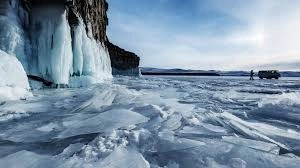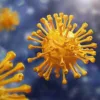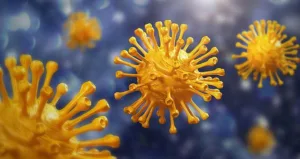
Zombie Virus and Melting Permafrost
Introduction
Zombie Virus in Melting Permafrost as climate change accelerates, it not only reshapes our environment but also unearths ancient threats long buried beneath the Earth’s surface. Among these are the so-called “zombie viruses”—prehistoric pathogens preserved in permafrost for tens of thousands of years. Scientists have begun to study these ancient viruses to understand their potential impact on modern ecosystems and human health.

What Is a Zombie Virus?
The term “zombie virus” refers to ancient viruses that have remained dormant in frozen environments like permafrost for millennia. These viruses are not fictional; researchers have successfully revived some of them in laboratory settings. For instance, in 2014, scientists reactivated Pithovirus sibericum, a 30,000-year-old virus found in Siberian permafrost. More recently, in 2022, researchers revived Pandoravirus yedoma, estimated to be around 48,500 years old .
The Science Behind Permafrost and Virus Preservation
Permafrost is a layer of soil or sediment that remains frozen for at least two consecutive years. It covers about 15% of the Northern Hemisphere and acts as a natural freezer, preserving organic material, including microbes and viruses, for extended periods. The cold, oxygen-free conditions of permafrost slow down decomposition, allowing viruses to remain intact and potentially infectious even after tens of thousands of years .

Recent Discoveries and Research
In recent years, scientists have intensified efforts to study Zombie Virus in Melting Permafrost. A notable study reported the revival of 13 new viruses from seven different ancient Siberian permafrost samples. These viruses belong to five different clades and primarily infect amoebas . While these particular viruses do not pose a direct threat to humans, their revival demonstrates the resilience of ancient pathogens and raises concerns about what other viruses might emerge as permafrost continues to thaw.
Potential Risks to Human and Animal Health
The primary concern is that melting permafrost could release ancient viruses capable of infecting humans or animals. While most revived viruses to date have targeted amoebas, the possibility exists that other, more dangerous pathogens could resurface. For example, in 2016, a thawing reindeer carcass in Siberia released anthrax spores, leading to an outbreak that affected dozens of people and resulted in the death of a child .

Moreover, scientists warn that ancient viruses could possess genetic material unfamiliar to modern immune systems, potentially leading to outbreaks for which we have no existing immunity or treatments.
Climate Change as a Catalyst
Global warming is the driving force behind the thawing of permafrost. As temperatures rise, previously frozen regions begin to melt, exposing ancient organic matter and the pathogens within. This process not only threatens to release ancient viruses but also contributes to the release of greenhouse gases like methane and carbon dioxide, further exacerbating climate change .
Monitoring and Preventive Measures
To mitigate the risks associated with ancient pathogens, scientists advocate for increased monitoring of permafrost regions. Establishing Arctic monitoring networks can help detect and contain emerging threats early. Additionally, researchers emphasize the importance of studying these ancient viruses to understand their structures, behaviors, and potential impacts on current ecosystems and public health .
Conclusion
The revival of ancient “zombie viruses” from melting permafrost underscores the interconnectedness of climate change, environmental health, and human well-being. As we continue to grapple with the effects of global warming, it’s crucial to invest in research and monitoring to anticipate and prevent potential biological threats emerging from the Earth’s thawing frontiers.
By
SVV BHADRA P ,
Medical Expert & Medical Psychologist
M.Sc. Psychology, M.Sc. Microbiology, M.Sc. Zoology, M.PHil, D.Pharm, DRUG EXPERT.
About the Author:
SVV BHADRA P is a qualified medical expert with over 10 years of experience in clinical and psychological healthcare. He holds Master’s degrees in Psychology, Microbiology, and Zoology, M.PHil along with a Diploma in Pharmacy and a certification in First Aid. Passionate about integrating medical science with mental wellness and preventive care, he also explores holistic approaches including astrological influences on health.








Add comment